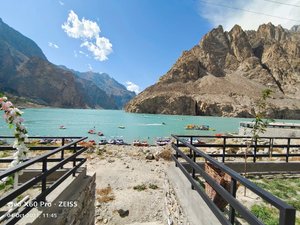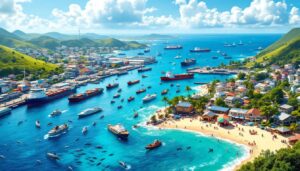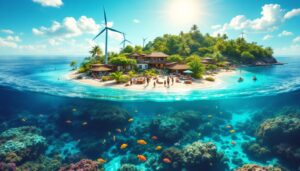Let’s dive into the heart of the maritime wonders of Pakistan, a country with breathtaking landscapes where the sea meets the azure sky. Exploring the Blue Horizons of Pakistan invites us to discover a world rich in biodiversity and culture, revealing hidden treasures along its coasts. These maritime regions are not only a spectacle for the eyes, they are also vital ecosystems that are home to a multitude of marine species.
Pakistan, with its maritime coastline which extends for approximately 1,046 kilometers, offers an exceptional setting for adventure and discovery. Pristine beaches, pristine islands and colorful coral reefs invite nature, diving and fishing enthusiasts to explore. By diving into the depths of these waters, anyone can feel the importance of conserving these natural wealth, essential to the ecological balance of the region.
This trip will be an opportunity to introduce Pakistan’s maritime riches and raise awareness about the importance of their preservation for future generations.
Table of Contents
ToggleExploring Pakistan’s Blue Horizons: A Journey to the Heart of Marine Innovation
Pakistan, with its vast maritime expanses, offers an incredible wealth of biodiversity and maritime resources. According to recent studies, almost 35% of marine species Threatened species find refuge in these waters, highlighting the importance of conserving and developing this unique ecosystem. Thanks to the UNESCO World Heritage Convention, many innovative projects are emerging to explore and protect these blue horizons, while promoting sustainable use of resources.
Key Data on Pakistan’s Blue Economy
With a coastline of more than 1,046 km Along the Arabian Sea, Pakistan has immense maritime economic potential. Recent reports from theOECD indicate that the maritime economy could represent up to 3% of national GDP by 2030, thus contributing significantly to the country’s prosperity. In 2022, the fishing sector generated approximately $1.8 billion exports, drawing attention to the need for policies to support this vital industry.
The Pakistani government has launched ambitious initiatives aimed at integrating ecological sustainability to economic development. For example, the Integrated Coastal Zone Management project was introduced to restore damaged ecosystems while promoting local economic development. This project not only aims to improve biodiversity but to strengthen the resilience of coastal communities to the effects of climate change.
Case Studies: Successful Conservation Initiatives
A striking example of success is the mangrove reforestation programs launched along the Pakistani coast. In Karachi, these initiatives helped restore more than 37,000 hectares of mangroves, helping to protect coastlines against erosion while providing crucial habitat for many maritime species. These mangroves play an essential role in regulating water quality and mitigating the impacts of storms.
Partnerships between NGOs and local communities have demonstrated that awareness and community engagement are key elements for the success of these projects. By integrating the traditional knowledge of local fishermen into conservation strategies, the results are even more convincing and adapted to local reality.
Futuristic Perspectives: Towards a New Conception of Marine Exploration
In the future, Pakistan could adopt a proactive approach tomarine innovation. By investing in ocean monitoring technologies, the country could better understand the state of its maritime resources. Initiatives like those of WWF to use drones and underwater sensors in monitoring biodiversity show how new technologies can save thousands of marine species.
THE collaborative projects international organizations, such as those supported by UNESCO, also provide a unique opportunity for Pakistan to share its experiences and learn from others. By participating in international forums, the country could not only strengthen its reputation for conservation but also attract foreign investment in the maritime sector.
Scientific research on marine ecosystems could also benefit from an orientation towards the formation of interdisciplinary teams. By uniting marine biologists, economists and public policy experts, the country could develop integrated strategies to navigate future challenges related to the blue economy and the preservation of ocean ecosystems.
For more information on global conservation efforts and best practices, readers can view reports available on platforms like WWF or explore events and workshops organized by UNESCO.
Finally, for those who wish to engage more in literary exploration around these themes, the bookstore Exploring Time offers a selection of works that highlight marine issues and the need to act to preserve the oceans.

Au Pakistan, les mariages forcés en hausse à cause du dérèglement climatique https://t.co/T9WbC2N3LS
— Le Monde (@lemondefr) August 30, 2024
FAQs on Exploring Blue Horizons of Pakistan
What is the “Explore Blue Horizons” initiative in Pakistan?
The initiative aims to promote and preserve the country’s *marine* and *coastal* resources while raising public awareness about the importance of marine *biodiversity*.
Why are Pakistan’s blue skylines important?
These horizons are essential because they support a variety of marine species and coastal landscapes, which are crucial to the ecosystem and the local economy, particularly for *fishing* and *tourism*.
What endangered species are found in these waters?
Pakistan’s waters are home to around 35% of endangered marine species, including *sea turtles* and some fish species, highlighting the need to protect these habitats.
How is the Pakistani government supporting this initiative?
The government implements conservation policies, funds marine research projects and collaborates with international organizations to protect these maritime riches.
How can individuals participate in this initiative?
Individuals can get involved by participating in awareness campaigns, supporting conservation projects and adopting sustainable practices during their activities at sea.









